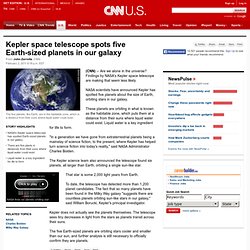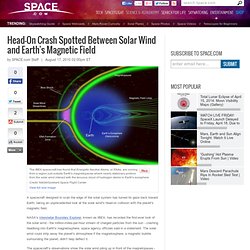

Five New Exoplanets Discovered. NASA’s Kepler space telescope has discovered its five new exoplanets, or planets beyond our solar system.

Newly found planets were named Kepler 4b, 5b, 6b, 7b and 8b. The new exoplanets range in size from similar to Neptune to larger than Jupiter. “These observations contribute to our understanding of how planetary systems form and evolve from the gas and dust disks that give rise to both the stars and their planets,” said William Borucki of NASA’s Ames Research Center in Moffett Field, Calif.
Borucki is the mission’s science principal investigator. “The discoveries also show that our science instrument is working well. The newly discovered planets are known as “hot Jupiter” because of their high massses and extreme temperatures. “It’s gratifying to see the first Kepler discoveries rolling off the assembly line,” said Jon Morse, director of the Astrophysics Division at NASA Headquarters in Washington.
Related Posts : Space telescope spots five Earth-sized planets in our galaxy. From John Zarrella, CNN February 2, 2011 8:18 p.m.

EST The five planets, like Earth, are in the habitable zone, which is a distance from their suns where liquid water could exist. NASA's Kepler space telescope has spotted Earth-sized planets in our galaxyThere are five plants in distances from their suns where liquid water could existLiquid water is a key ingredient for life to form (CNN) -- Are we alone in the universe? NASA scientists have announced Kepler has spotted five planets about the size of Earth, orbiting stars in our galaxy.
These planets are orbiting in what is known as the habitable zone, which puts them at a distance from their suns where liquid water could exist. "In a generation we have gone from extraterrestrial planets being a mainstay of science fiction, to the present, where Kepler has helped turn science fiction into today's reality," said NASA Administrator Charles Bolden. NASA finds six planets orbiting star That star is some 2,000 light years from Earth.
Black-Holes. Pole shift? Head-On Crash Spotted Between Solar Wind and Earth's Magnetic Field (Build 20100722155716) A spacecraft designed to scan the edge of the solar system has turned its gaze back toward Earth, taking an unprecedented look at the solar wind's head-on collision with the planet's magnetic field.

NASA's Interstellar Boundary Explorer, known as IBEX, has recorded the first-ever look of the solar wind - the million-miles-per-hour stream of charged particles from the sun - crashing headlong into Earth's magnetosphere, space agency officials said in a statement. The solar wind could strip away the planet's atmosphere if the magnetosphere, a magnetic bubble surrounding the planet, didn't help deflect it. The spacecraft's observations show the solar wind piling up in front of the magnetopause - the boundary between Earth's magnetosphere and space, about 35,000 miles (56,327 km) toward the sun. The interaction is invisible to the human eye, but not to IBEX's sensors.
"Where the interaction is strongest, there are only about eight hydrogen atoms per cubic centimeter," study leader Stephen A.
The Milky Way. Tech. We come from the future.